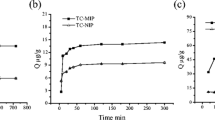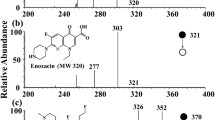Abstract
This work describes the development and application of class-selective molecularly imprinted polymers (MIPs) for the analysis of beta-lactamase-resistant penicillins, namely cloxacillin (CLOXA), oxacillin (OXA), and dicloxacillin (DICLOXA), in milk samples. Our method is based on molecularly imprinted solid-phase extraction (MISPE) coupled to high-performance liquid chromatography (HPLC) with diode-array detection (DAD). 2-Biphenylylpenicillin (2BPEN), a surrogate with a close resemblance to beta-lactamase-resistant penicillins in terms of size, shape, hydrophobicity, and functionality, was synthesized and used as the template for the polymer synthesis. A MIP library was prepared and screened to select the optimum functional monomer, N-(2-aminoethyl)methacrylamide, and cross-linker, trimethylolpropane trimethacrylate, that provided the best recognition for the target antibiotics. For the MISPE application, the MIPs were prepared in the form of microspheres, using porous silica beads (40–75 μm) as sacrificial scaffolds. The developed MISPE method enables efficient extraction from aqueous samples and analysis of the antimicrobials, when followed by a selective washing with 2 mL acetonitrile–water (20:80 v/v) and elution with 1 mL 0.05 mol L−1 tetrabutylammonium in methanol. The analytical method was validated according to EU guideline 2002/657/EC. The limits of quantification (S/N = 10) were in the 5.3–6.3 μg kg−1 range, well below the maximum residue limits (MRLs) currently established. Inter-day mean recoveries were in the range 99–102 % with RSDs below 9 %, improving on the performance of previously reported MISPE methods for the analysis of CLOXA, OXA, or DICLOXA in milk samples.




Similar content being viewed by others
References
Sales of veterinary antimicrobial agents in 26 EU/EEA countries in 2012, European Surveillance of Veterinary Antimicrobial Consumption (ESVAC). http://www.ema.europa.eu/ema/index.jsp?curl=pages/regulation/document_listing/document_listing_000302.jsp. Online document
Gorbach SL, Bartlett JG, Blacklow NR (2004) Infectious diseases, 3rd edn. Lippincott Williams & Wilkins, Philadelphia
De Briyne N, Atkinson J, Pokludová L, Borriello SP (2014) Antibiotics used most commonly to treat animals in Europe. Vet Rec 175:325–332
Annual antimicrobial resistance surveillance reports (2013) European Centre for Disease Prevention and Control. http://ecdc.europa.eu/en/publications/surveillance_reports/arhai/Pages/annual-antimicrobial-resistance-surveillance-report.aspx. Online document
Barton MD (2000) Antibiotic use in animal feed and its impact on human health. Nutr Res Rev 13:279–299
http://www.fas.usda.gov/maximum-residue-limits-mrl-database. Accessed 14 May 2015
Commission Regulation (EU) No 37/2010 of 22 December 2009 on pharmacologically active substances and their classification regarding maximum residue limits in foodstuffs of animal origin. (2010) Off. J. Eur. Union, L15:1–72
http://www.codexalimentarius.net/mrls/vetdrugs/jsp/vetd_q-s.jsp. Accessed 14 May 2015
Botsoglou NA, Fletouris DJ (eds) (2000) Drugs residues in foods: pharmacology, food safety and analysis. Marcel Dekker Inc., New York
Cogliani C, Goossens H, Greko C (2011) Restricting antimicrobial use in food animals: lessons from Europe. Microbe 6:274–279
Pyorala S, Taponen J, Katila T (2014) Use of antimicrobials in the treatment of reproductive diseases in cattle and horses. Reprod Dom Anim 49:16–26
Kantiani L, Farre M, Barcelo D (2009) Analytical methodologies for the detection of β-lactam antibiotics in milk and feed samples. Trends Anal Chem 28:729–743
Lara FJ, del Olmo-Iruela M, Cruces-Blanco C, Quesada-Molina C, García-Campaña AM (2012) Advances in the determination of β-lactam antibiotics by liquid chromatography. Trends Anal Chem 38:52–66
Junza A, Dorival-García N, Zafra-Gómez A, Barróna D, Ballesteros O, Barbosa J, Navaló A (2014) Multiclass method for the determination of quinolones and β-lactams, in raw cow milk using dispersive liquid-liquid microextraction and ultra high performance liquid chromatography-tandem mass spectrometry. J Chromatogr A 1356:10–22
Msagati TAM (2007) Nindi MM (2007) Determination of β-lactam residues in foodstuffs of animal origin using supported liquid membrane extraction and liquid chromatography-mass spectrometry. Food Chem 100:836–844
Junza A, Montane A, Barbosa J, Minguillon C, Barron D (2014) High resolution mass spectrometry in the identification of transformation products and metabolites from β-lactam antibiotics in thermally treated milk. J Chromatogr A 1368:89–99
Pereira RV, Siler JD, Bicalho RC, Warnick LD (2014) Multiresidue screening of milk withheld for sale at dairy farms in central New York State. J Dairy Sci 97:1513–1519
Karageorgou EG, Samanidou VF (2012) Development and validation according to European Union Decision 2002/657/EC of an HPLC-DAD method for milk multi-residue analysis of penicillins and amphenicols based on dispersive extraction by QuEChERS in MSPD format. J Separ Sci 34:1893–1901
Piñero MI, Bauza R, Arce L, Valcarcel M (2014) Determination of penicillins in milk of animal origin by capillary electrophoresis: is sample treatment the bottleneck for routine laboratories? Talanta 119:75–82
Babington R, Matas S, Marco MP, Galve R (2012) Current bioanalytical methods for detection of penicillins. Anal Bioanal Chem 403:1549–1566
Beltrán MC, Borràs M, Nagel O, Althaus RL, Molina MP (2014) Validation of receptor-binding assays to detect antibiotics in goat's milk. J Food Protect 77:308–313
Gross M, Rodríguez-Mozaza S, Barceló D (2013) Rapid analysis of multiclass antibiotic residues and some of their metabolites in hospital, urban wastewater and river water by ultra-highperformance liquid chromatography coupled to quadrupole-linear ion trap tandem mass spectrometry. J Chromatogr A 1292:173–188
Haupt K (ed) (2012) Molecular Imprinting. Springer, Heidelberg, Germany
Urraca JL, Schillinger E, Esselmann H, Wiltfang J, Sellergren B (2011) Polymeric complements to the Alzheimer's disease biomarker β-amyloid isoforms Aβ1–40 and Aβ1–42 for blood serum analysis under denaturing conditions. J Amer Chem Soc 133:9220–9223
Zhang J, Wangy H, Liuy W, Bai L, Ma N, Lu J (2008) Synthesis of molecularly imprinted polymer for sensitive penicillin determination in milk. Anal Lett 4:3411–3419
Royen GV, Dubruel P, Daeseleire E (2014) Development and evaluation of a molecularly imprinted polymer for the detection and cleanup of benzylpenicillin in milk. J Agric Food Chem 62:8814–8821
Zhang X, Chen L, Xua Y, Wang H, Zeng Q, Zhao Q, Ren N, Ding L (2010) Determination of β-lactam antibiotics in milk based on magnetic molecularly imprinted polymer extraction coupled with liquid chromatography–tandem mass spectrometry. J Chromatogr B 878:3421–3426
Díaz-Bao M, Barreiro R, Miranda JM, Cepeda A, Regal P (2015) Fast HPLC-MS/MS method for determining penicillin antibiotics in infant formulas using molecularly imprinted solid-phase extraction. J Anal Meth Chem 959675/1–8
Du W, Zhou H, Luo Z, Zheng P, Guo P, Chang R, Chang C, Fu Q (2014) Selective determination of penicillin G from tap water and milk samples using surface molecularly imprinted polymers as solid-phase extraction sorbent. Mol Impr 2:18–29
Giovannoli C, Anfossi L, Biagioli F, PassiniC BC (2013) Solid phase extraction of penicillins from milk by using sacrificial silica beads as a support for a molecular imprint. Microchim Acta 180:1371–1377
http://www.sanidadanimal. Bayerandina.com. Accessed 14 May 2015
Urraca JL, Marazuela MD, Merino ER, Orellana G, Moreno-Bondi MC (2006) Molecularly imprinted polymers with a streamlined mimic for zearalenone analysis. J Chromat A 1116:127–134
Commission Decision 2002/657/EC of 12 August implementing Council Directive 96/23/EC concerning the performance of analytical methods and the interpretation of the results. (2002) Off. J. Eur. Union L, 221:8–36
Hall AJ, Manesiotis P, Emgenbroich M, Quaglia M, de Lorenzi E, Sellergren B (2005) Urea host monomers for stoichiometric molecular imprinting of oxyanions. J Org Chem 70:1732–1736
Branca M, Pena S, Guillot R, Gori D, Alezra V, Kouklovsky C (2009) Memory of chirality of tertiary aromatic amides: a simple and efficient method for the enantioselective synthesis of quaternary α-amino acids. J Am Chem Soc 131:10711–10718
Hoover JRE, Chow AW, Stedman RJ, Hall NS, Greenberg HS, Dolan MM, Ferlauto RJ (1964) Semisynthetic penicillins. I. 2-biphenylylpenicillins. J Med Chem 7:245–251
Sellergren B, Shea KJ (1993) Influence of polymer morphology on the ability of imprinted network polymers to resolve enantiomers. J Chromatogr 637:31–49
Calculated using Advanced Chemistry Development (ACD/Labs) software V11.02
Zerara M, Brickmann J, Kretschmer R, Exner TE (2009) Parameterization of an empirical model for the prediction of n-octanol, alkane and cyclohexane/water as well as brain/blood partition coefficients. J Comput Aided Mol Des 23:105–111
Benito-Peña E, Moreno-Bondi MC, Aparicio S, Orellana G, Cedefur J, Kempe M (2006) Molecular engineering of fluorescent penicillins for molecularly imprinted polymer assays. Anal Chem 78:2019–2027
Urraca JL, Moreno MC, Hall A, Sellergren B (2006) A stoichiometric molecularly imprinted polymer for the class-selective recognition of antibiotics in aqueous media. Angew Chem Int Ed 45:5158–5161
Urraca JL, Moreno MC, Hall A, Sellergren B (2007) Direct extraction of penicillin G and derivatives from aqueous samples using a stoichiometrically imprinted polymer. Anal Chem 76:695–701
Sucha L, Kotryl S (1972) Solution equilibria in analytical chemistry. Van Nostrans Reinhold, New York
Calculated using Marvin Sketch software V5.12 from Chem Axon (www.chemaxon.com)
Rampey AM, Umpleby RJ, Rushton GT, Iseman JC, Shah RN, Shimizu KD (2004) Characterization of the imprint effect and the influence of imprinting conditions on affinity, capacity, and heterogeneity in molecularly imprinted polymers using the Freundlich isotherm-affinity distribution analysis. Anal Chem 786:1123–1133
Wulandari M, Urraca JL, Descalzo AB, Amran MB, Moreno-Bondi MC (2015) Molecularly imprinted polymers for cleanup and selective extraction of curcuminoids in medicinal herbal extracts. Anal Bioanal Chem 407:803–812
Benito-Peña E, Partal-Rodera AI, León-González ME, Moreno-Bondi MC (2006) Evaluation of mixed mode solid phase extraction cartridges for the preconcentration of beta-lactam antibiotics in wastewater using liquid chromatography with UV-DAD detection. Anal Chim Acta 556:415–422
Poole CF, Poole SK (2002) In: Simpson NJK (ed) In: Theory meets practice. Solid phase extraction: principles, techniques and applications. Marcel Dekker Inc, New York, pp 183–226
Acknowledgments
This work was supported by MICINN (INNPACTO IPT-060000-2010-14, MIPFOOD project) and MINECO (CTQ2012-37573-C02). The authors thank Priégola Cattle Farm (Madrid, Spain) for providing the milk samples. J.L. Urraca thanks the CEI-Moncloa for a post-doctoral contract.
Conflict of interest
The authors have no conflict of interest to declare.
Author information
Authors and Affiliations
Corresponding authors
Additional information
Published in the topical collection Analytical Applications of Biomimetic Recognition Elements with guest editors Maria C. Moreno-Bondi and Elena Benito-Peña.
Electronic supplementary material
Below is the link to the electronic supplementary material.
ESM 1
(PDF 107 kb)
Rights and permissions
About this article
Cite this article
Urraca, J.L., Chamorro-Mendiluce, R., Orellana, G. et al. Molecularly imprinted polymer beads for clean-up and preconcentration of β-lactamase-resistant penicillins in milk. Anal Bioanal Chem 408, 1843–1854 (2016). https://doi.org/10.1007/s00216-015-8941-6
Received:
Revised:
Accepted:
Published:
Issue Date:
DOI: https://doi.org/10.1007/s00216-015-8941-6




